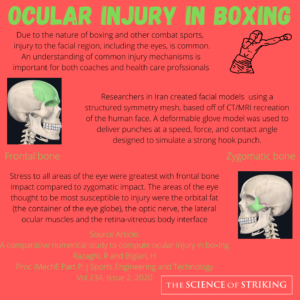BACKGROUND
Due to the nature of boxing and other combat sports, structural damage to the facial region, including the eyes, is common. Because of this, it is thought that boxing poses a high risk of altered visual acuity. Whilst epidemiological studies have investigated the occurrence of facial and eye injuries, there have not yet been any studies recreating the biomechanics of punching utilizing a facial model.
METHODS
Models were created using a structured symmetry mesh, based off of CT/MRI recreation of the human face. A deformable glove model was used to deliver punches at a speed, force, and contact angle designed to simulate a strong hook punch to the frontal (at an angle of 0 degrees) and zygomatic (at an angle of 20 degrees) bones.
FINDINGS
The force used for this study was significantly less than the force required to cause bony failure to the frontal and zygomatic bones of the skull. All areas of the eye were stressed to a much greater degree with frontal impact compared to zygomatic impact.
The structures of the eye most likely to be impacted by punch force were the orbital fat (the container of the eye globe), the optic nerve, and the retina-vitreous body interface.
Stress to the iris, lens and ciliary body was in the lateral circumference, which may cause damage to the ocular muscles and impair eye function.
Stress to the cornea, with impact to both areas, was mainly in the lateral circumference and the aqueous body, and was not sufficient to cause significant damage.
IMPLICATIONS
Whilst this study using a 3D biomechanical model contributes to our understanding of the impact of punching force to specific anatomical structures around the eye, care needs to be taken in extrapolating these findings to to a live dynamic human model, whilst is likely to respond to trauma in a much more complicated fashion.
